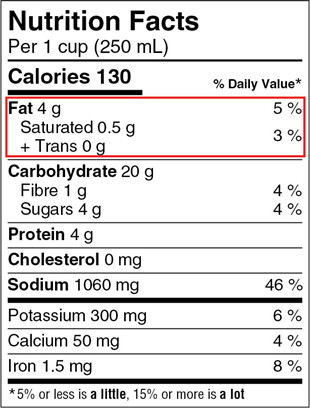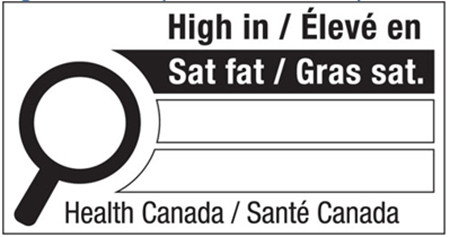Fats: Using the food labels
Learn how to use the information on food labels to help you choose foods with healthier fats.
On this page
Fats in the nutrition facts table
In Canada, almost all prepackaged foods must have a nutrition facts table. This information can help you make healthier food choices.
When you're buying prepackaged foods, you can compare the amount of fats in different foods by using the nutrition facts table. The table shows the % daily value (% DV), the type and amount of fat.
When looking at the nutrition facts table, you will notice:
- an overall fat category
- saturated and trans fats are listed together

Nutrition facts table – Text description
Left justified at the top of the table is the heading Nutrition Facts in bold. The next line is Per 1 cup open parenthesis 250 mL close parenthesis. There is a rule below 1 cup open parenthesis 250 mL close parenthesis that spans the width of the table. The next line is Calories in bold followed by 130, also in bold. Right justified on the same line is the subheading percent symbol Daily Value in bold. Percent Daily Value has an asterisk that refers to a footnote at the bottom of the Nutrition Facts table. There is a thick rule under Calories that ends after the 130; it does not span the width of the table.
Left justified on the next line is Fat in bold followed by 4 and a lowercase g. Right justified on the same line is 5 followed by a percent symbol. Indented on the next line under Fat is Saturated and 0.5 and a lowercase g. Indented on the next line under Saturated there is a plus symbol followed by Trans followed by 0 and a lowercase g. There is a 3 for the combined percent Daily Value for saturated and trans fat which is right justified and vertically centred against the saturated and trans information on the left. It is followed by a percent symbol. There is a thin rule below the Trans information that spans the width of the table. Surrounding the information for fat, saturated and trans described above is a thin, red rectangular box to highlight this information.
The next line is Carbohydrate in bold followed by 20 and a lowercase g. Indented on the next line under Carbohydrate is Fibre followed by 1 and a lowercase g. Right justified on the same line is 4 followed by a percent symbol. Indented on the next line under Fibre is Sugars followed by 4 and a lowercase g. Right justified on the same line is 4 followed by a percent symbol. There is a thin rule under the sugars information that spans the width of the table.
The next line is Protein in bold followed by 4 and a lowercase g. There is a thin rule under the protein information that spans the width of the table.
The next line is Cholesterol in bold followed by 0 and mg in lowercase. There is a thin rule under the cholesterol information that spans the width of the table.
The next line is Sodium in bold followed by 1060 and mg in lowercase. Right justified on the same line is 46 followed by a percent symbol. There is a thick rule under the sodium information that spans the width of the table.
The next line is Potassium followed by 300 and mg in lowercase. Right justified on the same line is 6 followed by a percent symbol. There is a thin rule under the potassium information that spans the width of the table.
The next line is Calcium followed by 50 and mg in lowercase. Right justified on the same line is 4 followed by a percent symbol. There is a thin rule below the calcium information that spans the width of the table.
The next line is Iron followed by 1.5 and mg in lowercase. Right justified on the same line is 8 followed by a percent symbol. There is a thick rule under the iron information that spans the width of the Nutrition Facts table.
The next line is the percent Daily Value footnote that was referred to at the beginning of the table description. The footnote starts with an asterisk followed by the statement: 5 percent symbol or less is a little, 15 percent symbol or more is a lot. The terms a little and a lot are in bold. This is the end of the Nutrition Facts table.
The % daily values (% DV) on the nutrition facts table can be used as a guide to show you if the serving of stated size has a little or a lot of a nutrient.
- 5% DV or less is a little
- 15% DV or more is a lot
Changes to the food label
Learn more about food labelling changes, including improvements to the nutrition facts table and list of ingredients and the introduction of a front-of-package nutrition symbol. These changes will help make the healthier choice the easier choice.

Example of a nutrition symbol - Text description
This figure shows a nutrition symbol for the principal display panel that indicates that a prepackaged product is high in saturated fat. This symbol is bilingual, with the English text shown first, followed by the French text. There is a white rectangular box outlined by a thin black line. At the top of the box is a heading composed of the words “High in” followed by a forward slash and the words “Élevé en” in black, bold, lower case letters, except that the first letter of the words “High” and “Élevé” are in upper case. Under the heading is a left-justified black magnifying glass with three bars stacked to its right. There is a small amount of white space between the magnifying glass and the left side of the three bars. This left side forms a concave curve that follows the curvature of the magnifying glass. There is a small amount of white space between each bar, as well as between the right side of the bars and the thin black line that outlines the box. The first bar is black and contains the words “Sat fat” followed by a forward slash and the words “Gras sat.” in white, bold, lower case letters, except that the first letter of the words “Sat” and “Gras” are in upper case. The second and third bars are white, are outlined by a thin black line and contain no words. Centred at the bottom of the box are the words “Health Canada” followed by a for- ward slash and the words “Santé Canada” in black, lower case letters, except that the first letter of each word is in upper case.